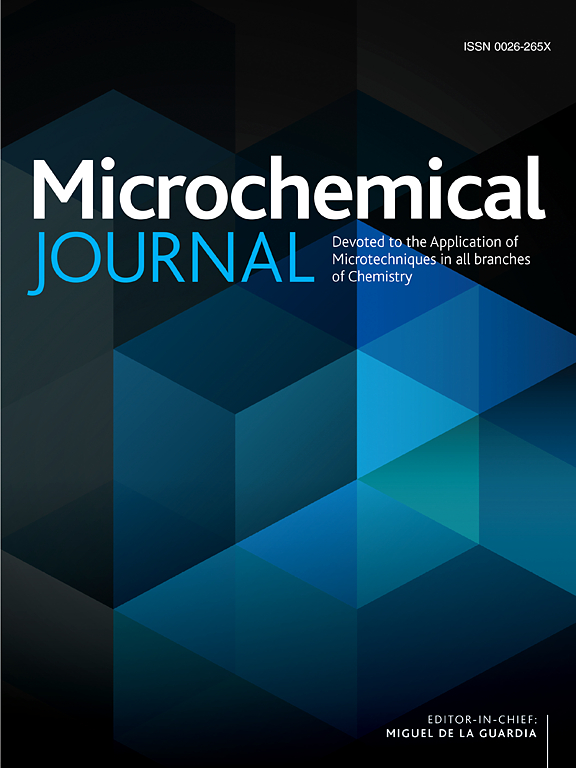基于近红外光谱和改进的 DenseNet 模型的玉米种子品种识别方法
IF 4.9
2区 化学
Q1 CHEMISTRY, ANALYTICAL
引用次数: 0
摘要
开发一套实时在线系统,用于快速、无损地识别种子品种,可显著提高现代农业的生产效率。近红外光谱技术因其快速、无损的特点,已成为种子品种识别的常用技术之一。然而,现有的卷积神经网络难以反映近红外光谱复杂的非线性关系,导致建模性能较差,且模型复杂度较高,不利于实时在线识别任务的完成。因此,本研究提出了一种利用近红外光谱技术和轻量级深度学习网络(BAC-DenseNet)的玉米种子品种识别方法。首先,以 5 种不同类型的玉米种子共 750 个样本为研究对象。利用 SGD-SNV 对光谱数据进行预处理,识别准确率平均提高了 15.78%。然后,使用吸引-排斥优化算法结合拉普拉卡特征图(AROA-LE)对预处理后的数据进行降维处理,维度从 1845 降到 66。最后,在 DenseNet-121 网络的基础上构建了轻量级深度学习网络模型(BAC-DenseNet),并进行了层剪枝,引入了批通道归一化(BCN)、自注意和卷积混合模块(ACmix)以及卷积块注意模块(CBAM)。实验结果表明,所提出的 BAC-DenseNet 模型的识别准确率高达 99.33%。与原始网络和其他七个经典深度学习模型相比,所提出的方法在准确率、Kappa 和 MCC 方面分别平均提高了 2.83 %、3.52 % 和 3.47 %。同时,Params、Size 和 FLOPs 分别平均减少了 9.09 M、35.08 MB 和 88.66 M。该方法在玉米种子品种鉴定方面具有较高的准确性和可靠性,可为玉米种子品种的育种、种植和管理提供定性指标。该研究可为其他农产品的品种鉴定提供参考方法。本文章由计算机程序翻译,如有差异,请以英文原文为准。
A method of maize seed variety identification based on near-infrared spectroscopy combined with improved DenseNet model
The development of a real-time online system for rapid and non-destructive identification of seed varieties can significantly improve production efficiency in modern agriculture. Near-infrared spectroscopy technology has become one of the commonly used techniques in seed variety identification due to its fast and non-destructive characteristics. However, existing convolutional neural networks are difficult to reflect the complex nonlinear relationships of the near-infrared (NIR) spectrum, resulting in poor modeling performance, and their high model complexity is not conducive to real-time online identification tasks. Therefore, this study proposes a maize seed variety identification method using near-infrared spectroscopy technology and lightweight deep learning network (BAC-DenseNet). First, a total of 750 samples from 5 different types of maize seeds were taken as the research object. The spectral data were pre-processing using the SGD-SNV, and the identification accuracy was improved by an average of 15.78 %. Then, the attraction–repulsion optimization algorithm combined with Laplacian Eigenmaps (AROA-LE) was used to perform dimension reduction on the pre-processed data, and the dimensionality was reduced from 1845 to 66. Finally, a lightweight deep learning network model (BAC-DenseNet) was constructed based on DenseNet-121 network with layer pruning and the introduction of batch channel normalization (BCN), self-attention and convolution mixed module (ACmix) and convolutional block attention module (CBAM). The experimental results show that the proposed BAC-DenseNet model has an identification accuracy of 99.33 %. Compared with the original network and seven other classical deep learning models, the proposed method has an average improvement of 2.83 %, 3.52 %, and 3.47 % in accuracy, Kappa, and MCC, respectively. Meanwhile, Params, Size, and FLOPs decreased by an average of 9.09 M, 35.08 MB, and 88.66 M, respectively. This method offered high accuracy and reliability in maize seed variety identification, which can provide qualitative indicators for the breeding, planting, and management of maize seed varieties. This study can provide a reference method for variety identification of other agricultural products.
求助全文
通过发布文献求助,成功后即可免费获取论文全文。
去求助
来源期刊

Microchemical Journal
化学-分析化学
CiteScore
8.70
自引率
8.30%
发文量
1131
审稿时长
1.9 months
期刊介绍:
The Microchemical Journal is a peer reviewed journal devoted to all aspects and phases of analytical chemistry and chemical analysis. The Microchemical Journal publishes articles which are at the forefront of modern analytical chemistry and cover innovations in the techniques to the finest possible limits. This includes fundamental aspects, instrumentation, new developments, innovative and novel methods and applications including environmental and clinical field.
Traditional classical analytical methods such as spectrophotometry and titrimetry as well as established instrumentation methods such as flame and graphite furnace atomic absorption spectrometry, gas chromatography, and modified glassy or carbon electrode electrochemical methods will be considered, provided they show significant improvements and novelty compared to the established methods.
 求助内容:
求助内容: 应助结果提醒方式:
应助结果提醒方式:


